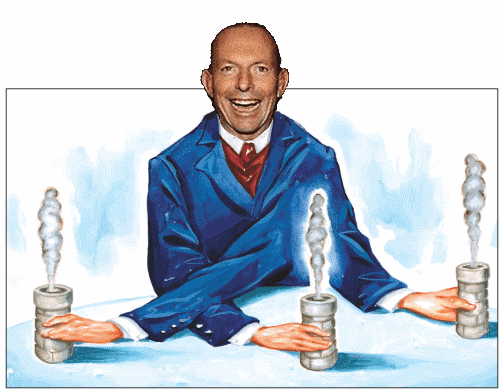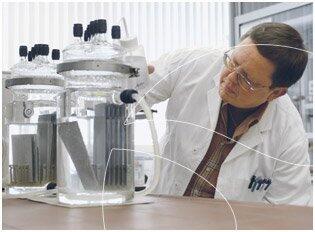An example of media bias against a price on carbon
Further details in the article:
What does media bias look like?
A post from The Telegraph blog of Piers Akerman - original at this link
Piers Akerman The Daily Telegraph June 23 2013 (12:00am)
HOLDEN workers meet at the company's Elizabeth plant in Adelaide this week to discuss a proposed 500 job cuts. The company has previously called the carbon tax "heavy and unfair"
The Coalition's plan to dump Labor's failed carbon dioxide tax will give the nation a boost should it put the government to rout in 82 days - but the renewable energy scam must be also be axed.
Australians are paying a huge price for nothing more than Green feel-good vanity politics that do nothing for the environment, the economy, the nation or the globe.
Last week, Maurice Newman, a former chairman of the Australian Stock Exchange and the ABC, and long regarded as one of the country's most respected business figures, told The Guardian that continuing taxpayer subsidies for the renewable energy target (RET) represented a "crime against the people".
Newman owns a property near a proposed wind farm in the NSW southern highlands and may be considered to have a conflict. But his argument against the expensive subsidies relies also on their effect on poorer households, and the apparent collapse of the scientific argument.
"When we look at the experience of Germany, they have not been successful in reducing emissions; when we look at the science it no longer supports the global warming theory; and when we look at the health and economic effects of wind farms and the obscene wealth transfer from poor to rich we have to ask: 'why are we persisting with them?' I think it is a crime against the people," he said.
The view of Newman, who would chair the opposition's proposed Business Advisory Council, is important.
"It is inevitable energy prices will be one of the issues that will be of concern to business," he said.
"Low energy prices are what has always made Australia internationally competitive and because of the RET and the carbon tax we have lost that advantage."
Newman wants to get Australian business back on its feet and so does Nationals Senator Ron Boswell, who last week spoke at a Canberra rally against renewables.
Boswell, one of the hardest working senators, will retire at the election, but he is going to fight renewables until his last day in office.
Wind power, which costs up to four times as much as coal or gas-fired power, can generate electricity only 30 per cent of the time, he told me.
"Those times are impossible to predict; wind has a reliability factor of a very low 8 per cent or less. Yet we are funnelling billions to set up unreliable wind turbines across Australia: money not from out of government's coffers but from the hip pockets of every energy user in Australia."
He then rattled off the names of some of the businesses endangered or killed because of the Green fetishists.
"This week, it was Simplot sending out a warning shot that its food manufacturing plants in Bathurst and Devonport are on the brink," he said. "Their energy costs have risen 80 per cent. "Last week, it was SPC Ardmona saying that unless it received emergency safeguards, more of its jobs would go. Its energy costs have risen. It is struggling to compete with home brand imports."
"Last month, it was farmers up in Bundaberg saying they couldn't afford to turn on irrigation pumps. The cost of electricity to pump water to their farms is set to jump 17.5 per cent a year for the next seven years.
"And we have already seen Heinz move its food processing operations to New Zealand, where it is 50 per cent cheaper to do business. Golden Circle closed its Northgate facility, costing 160 jobs, while Rosella closed all together," he said.
In parliament on Thursday, Opposition Leader Tony Abbott highlighted the absurdity of Labor's position by asking Prime Minister Julia Gillard to confirm that the carbon tax would increase to more than $24/tonne on July I and up to $25/tonne next year if the government is re-elected.
He wanted to know why her government kept raising the price when the European tax fell to $6/tonne and just 75c in New Zealand. Per usual, Prime Minister Gillard blustered about climate change and failed to provide a clear answer to a straightforward question.
Senator Boswell says farming and manufacturing in Australia are going under before our eyes. According to his figures, these policies are penalising Australians $13 billion a year, with the carbon tax costing $8 billion and the RET $5 billion.
Our food processing and manufacturing sectors are being annihilated. In 2011-12 alone, 7000 food processing jobs disappeared and 355 businesses closed or moved overseas. Since 2008, 110,000 manufacturing jobs have been lost.
Across Australia, food processors and manufacturers are cutting back to save costs: BlueScope Steel in Victoria, 170 jobs gone; Boral, 790 jobs gone; Penrice Soda in SA, 60 jobs gone; Pentair in western Sydney, 160 jobs; and Amcor, 300 jobs gone. Goodman Fielder will shut 15 factories, costing 600 jobs. Norsk Hydro aluminium smelter near Newcastle is closing, costing 350 jobs. Caltex is shutting its Kurnell refinery, costing 330 jobs.
Other companies are shifting overseas: Kerry Foods, 100 jobs gone; Kresta Blinds, 72 jobs; Cussons soaps, 75 jobs; Aerogard, 190 jobs; Harley-Davidson, 212 jobs; and Bosch, 380 jobs. Golden Circle has moved processing lines and jobs to New Zealand, while our second-last Australian-owned cannery, the Windsor Farm at Cowra, closed in March, costing 70 jobs.
The flow-on effects when a processor like Golden Circle or SPC Ardmona shuts its doors are devastating. Two years ago business warned Climate Change Minister Greg Combet that the carbon tax threatened the future of oil refinery investment in Australia, with Shell saying it would "break the camel's back". That same year, Holden said the carbon tax was a "heavy and unfair cost", since 85 per cent of the vehicles imported to Australia have no carbon tax associated with them.
The carbon tax has added around $412 to the price of a local car, while renewables have added about $200. That's twice Europe's car manufacturing costs and four times Asia's costs. Now Holden has shed 500 jobs and is asking those left to take pay cuts.
The Gillard government and unions have tried to put the blame for rising costs on other factors like the high Australian dollar. The truth is that Labor has given away our natural advantage of cheap and abundant energy in favour of expensive and unreliable renewables.






















